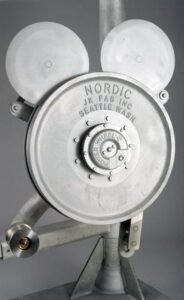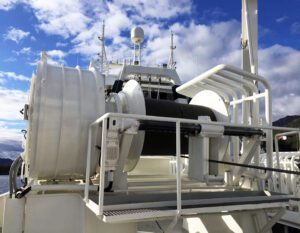Considering the demanding environment and modern technology, deck machinery geared toward commercial fishing vessels has been upgraded in recent years to improve efficiency, save time and money and work harder.
There have been several innovative solutions from both local and global companies that focus on enhancing winches, cranes, power blocks and equipment. Some of the most notable products on the market include rugged winches with customized control and automatic tension-line response, slinky pot conversions with simple rebuilds that increase torque and trawl winches operated via a motor connected directly to the drum.
Fishermen’s News reached out to several manufacturers and suppliers to find out the latest.

Markey Machine
Seattle-based Markey Machine is a longtime leader in providing marine winches and deck machinery solutions that are fully customizable. The company has a wide range of products, from anchor handling and mooring winches to cranes and capstans, all of which is designed to withstand the harsh marine environment.
Markey’s COM-series electric and hydraulic winches are a prime example of the company’s work. The line has long been used on a variety of vessels, Markey Machine VP of Business Development Scott Atkinson said.
“Markey’s COM-series winches are ideal for armored, fiber-optic or other specialty-cable operations, such as third-wire winches on trawlers,” he noted.
The COM-7E is a compact, lightweight, single-drum research winch with variable speed electric motor drive and level-wind designed for use with industry standards in conductivity, temperature and depth, water-sampling carousels and payloads typically used on inshore and coastal research vessels.
The 7E model includes variable speed control between zero- and 45-meters per-minute cable speed. It uses Markey-pioneered automatic-tension line control and has a maximum total-deck lift of 2,203 pounds.
“Markey’s Render/Recover controls provide constant tension on the cable,” Atkinson said.
There are a number of winch systems for the COM-series, including 3 HP, 5 HP, 7-1/2 HP, 10 HP and 15 HP electric versions available (hydraulic versions quoted on request). Performance ratings can be tailored to suit specific applications. Other winch-control systems are also available (pendant-type or joystick).
“The COM-7E model is but one of many examples, and we build these custom as well,” Atkinson said.
The COM winches are built rugged to withstand deep sea standards using materials and processes that provide maximum life and minimum maintenance.
More information is available at markeymachine.com.

Integrity Machining
Self-described as a “one-stop marine manufacturing shop,” Integrity Machining, based in Marysville, Wash., is a leader in the marine equipment industry. The company provides power blocks with power grips, long-line and crab-pot haulers, anchor winches, gurdys, davits and purse-seine winches, primarily for North Pacific and West Coast fisheries.
Integrity Machining has had a growth spurt in recent years, acquiring several notable industry brands and becoming the worldwide supplier of Kolstrand, J.K. Fabrication, NORDIC and Forfjord marine products.
For fishers that currently have a Nordic longline hauler and are debating converting to slinky pots, there is a solution that can utilize their current equipment with a simple rebuild, explained Integrity Machining General Manager Justin Fontes.
JK Fabrication’s founder, Jim Kreider, joined the team at Integrity Machining in 2020. One of his innovations—a way to increase the torque on the NORDIC 17-inch and 24-inch longline haulers for pulling the slinky pots in deeper depths.
As more boats switch to fishing slinky pots, the demand to get more torque out of the haulers was high. The NORDIC 17-inch and 24-inch longline haulers have been the go-to product for longliners on the West Coast and Alaska for many decades, Fontes noted.
“So, it made sense to come up with a solution to retrofit equipment customers already have on their boat,” he explained.
For the NORDIC 17-inch longline hauler, a much larger hydraulic motor can be retrofitted into the frame, which offers much more pulling torque and line speed. An optional mechanical dog mechanism to stop the sheaves from rotating backwards under heavy loads can also be added.
For the NORDIC 24-inch longline hauler, changing out the planetary gear set and switching the displacement of the hydraulic motor will provide an increase in torque by 30% on the standard single-reduction model. This is a cost-effective way to gain more torque, Fontes pointed out. In the conversion process, all the bearing and races, gears, seals and motor are replaced.
A lot of customers opt to do a complete overhaul at the time of the upgrade, including repairing and replacing worn or missing components, re-galvanizing and adding new hydraulic fittings or hoses. After the overhaul, it is sometimes hard to tell that the equipment isn’t brand new.
With current lead times on new planetary gearboxes, “it’s best to rebuild the existing one, saving on lead time and cost,” said Kreider said.
A new option for the double reduction that requires 25-40 gpm of flow is being developed and will be available for upgrades in the fall.
For more information, visit integritymachining.com and kolstrand.com.

Kongsberg Maritime
Norway-based marine systems provider Kongsberg Maritime offers various deck machinery and cranes, along with other commercial fishing systems.
The company has recently installed fishing winches that utilize direct-drive, permanent-magnet motors with gears mounted directly to the gearwheel and drum. By removing the traditional gearbox setup for trawl winches, an “acknowledged weak link,” according to Kongsberg officials, the risk of failure is reduced, and overall reliability is improved.
Other benefits include high efficiency and regenerative power, and the ability to boost pulling force by up to 30% for short periods. It also allows for direct transition and smoother, more dynamic operations.
“Kongsberg was early in the market to deliver electric winches to the pelagic trawler fleet,” Maritime Sales Manager Svein Hatlehol Henjesand explained. “This market has traditionally been mostly served by various high-pressure winches, while Kongsberg Maritime has also delivered dynamic low-pressure winches. We believe this has given us a head start in the current shift towards electric winches.”
The company recently delivered a large electric winch package to a new vessel for Faroe Islands fishing fleet operator, JFK. Kongsberg Maritime signed a contract with Tersan Shipyard in Turkey, to equip a 282-foot stern trawler. The package included four EasyDRIVE electric trawl winches with SmartPΩWER PM motors.
This will be the 13th stern trawler to be fitted with this system. In addition to the trawl winches, Kongsberg Maritime delivered winch control and monitoring systems, and a variable-speed drive.
JFK has been a longtime customer of Kongsberg for their hydraulic low-pressure winches, but now that electric trawl winches with direct drive are offered, they decided to adopt this form of drive on their new trawler, JFK CEO, owner Hanus Hansen said.
“Prior to concluding the contract with Tersan Shipyard, we consulted with the fishery company K. Halstensen and their crew on board the trawler Granit,” Hansen said. “They were early to install these electric winches and have gained several years of experience. The feedback from them has been very positive.”
Kongsberg Maritime also recently supplied a large electric winch package with PM motors for a pelagic trawler/purse seiner, currently being built for the Danish company Astrid Fiskeri A/S at Karstensens Skibsvaerft A/S in Denmark.
The contract included a set of powerful fishery and auxiliary winches, together with a large VSD package and the latest version of Kongsberg’s control and monitoring system. The fishing winches are being fitted with new electric multi-drive technology, developed by Kongsberg Maritime specifically for pelagic trawling and purse seining.
For more information, visit kongsberg.com/maritime.

Naust Marine
Headquartered in Iceland with a U.S. location in Poulsbo, Wash., Naust Marine has been designing and manufacturing deck machinery since 1993. The company focuses on electric winch, control and power management solutions that are environmentally friendly and operable in harsh conditions.
Naust’s automatic trawl winch control system is a popular product for the company, which services more than 150 fishing trawlers worldwide. It was developed over three decades of work from Naust technicians in cooperation with fishermen and ship owners.
The ATW control system allows for automatic load control for trawl winches. The system shoots the net to a pre-set length, decided by the operator for each evolution. It ensures that there is equal tension on both wires at all times.
The trawl is kept in optimal geometrical position by the ATW system, whether moving forward or going through cross-current or turning, which results in maximum catch with minimum operational cost.
Earlier this year, the company announced it will supply the ATW control system and other deck machinery solutions for a fishing trawler based out of the Falkland Islands.
In cooperation with fishing company Armadora Pereira and the Nodosa shipyard technical departments, Naust designed a customized package for the 278-foot vessel, owned by Orion Fishing Co. The complete deck package will be delivered at the end of 2023. This supply allows the new trawler to be ready to fish by early 2025.
In another package for a fishing vessel, Naust announced Jan. 24 that it would design and supply the complete electric winch and controls package with the ATW control system for a new scampi fishing vessel. This vessel, owned by Sanford Limited in New Zealand, is being built at the Damen Maaskant Shipyard and will fish in the South Ocean fishing grounds.
Delivery of the deck machinery solution is scheduled for early 2024.
In 1981, the icefish trawler Ottó N. Þorláksson became the first ship to receive the ATW control system from Naust Marine. In 1999, new Naust Marine trawl winches were installed and the control system onboard was updated.
Last year, the new owners of the vessel purchased two new Naust Marine electric trawl winches and a new automatic trawl winch control system to update the aging deck machinery.
Currently, the Ottó N. Þorláksson is preparing for fishing and expected to be south of Iceland this fall/winter.
For more information, visit naustmarine.com.
MacGregor
While MacGregor, which is part of Finland-based Cargotec, primarily focuses on cargo-related solutions in the offshore and marine industries, its double telescopic service cranes have been utilized on fishing vessels in the Pacific Northwest.
Triplex, a MacGregor company, is a major supplier of equipment to fishing fleets. The company is known for its Triplex net hauling equipment. It also offers net cranes, net winches and other deck cranes.
The compact shipboard cranes can be customized and are designed to perform a wide range of load handling tasks in challenging marine environments. Options include various slew-bearing dimensions and pedestal heights. The telescopic jib ensures that the crane can serve a large working area on the vessel. It can be controlled from an operator platform or a radio remote control.
This model has been installed on a diverse range of vessels in recent years, including a number of fishing vessels in the PNW.
Recently, MacGregor was contracted to deliver two large telescopic cranes for Manson Construction’s Frederick Paup, the largest ever self-propelled trailing suction hopper dredge built in the U.S.
For more information, visit macgregor.com.
Sara Hall has 15 years of experience at several regional and national magazines, online news outlets, and daily and weekly newspapers, where coverage has included reporting on local harbor activities, marine-based news, and regional and state coastal agencies. Her work has included photography, writing, design and layout.
